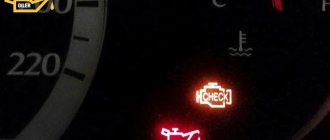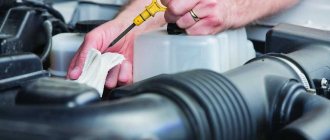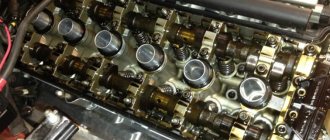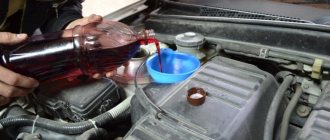The appearance of oil in the spark plug wells is fraught with the risk that sooner or later this will lead to failure of the ignition coil. Therefore, you can’t delay replacing it.
To replace you will need: a hairpin at least 140 mm long, an elastic band of 24 mm, a pair of washers, a bushing, 3 nuts. The largest nut will be the pull nut.
And of course new well seals.
We assemble such a primitive puller
Removing the top engine cover
Remove the spark plug tip and unscrew the spark plug
Now comes the fun part.
Without removing the receiver and valve cover, we insert a puller into the spark plug well, tighten the lower nut until the elastic band opens inside the well and the axial movement of the puller allows us to pull out the well.
The effort of one hand will be quite enough.
We put on new oil seals and generously lubricate them with engine oil to make it easier to install everything back.
The spark plug wells are inserted with a force 3 times less than when removed. In this case, there should be a characteristic click indicating correct installation. It's a click, not a crunch.
It is necessary to understand the reason why the oil turned out to be in the spark plug well of the VAZ 2110 after the main thing has been clarified. The reason for this factor may vary, and it also depends to some extent on the types of engines. On a VAZ 2110, oil in spark plug wells can lead to unpleasant consequences.
Check for leaks
It is a mistake to believe that when an oil leak occurs, only the problem of contamination of the power plant arises. Yes, this should also be taken as a serious problem, since gradual contamination negatively affects the general condition of the internal combustion engine and provokes the development of other problems and further malfunctions.
Since some of the oil leaves its permanent location, a phenomenon called lubrication deficiency or oil starvation occurs. In such a situation, you can expect accelerated wear of rubbing parts, jamming, and even major repairs if nothing is done in the early stages of the problem.
In order for the motorist to be able to constantly monitor the level and condition of the lubricant, automakers have provided for the installation of a special oil dipstick. It should definitely be used periodically in order to detect leaks in a timely manner and prevent their serious consequences.
Car owners often have to deal with situations where oil is found in spark plug wells. There is a fairly simple way to check the condition of the candles. To do this, you need to dismantle the candles themselves, take a flashlight and shine it directly into the cavity in which the candle is placed. This cavity is called a well.
As practice and experience of motorists shows, oil is not found in all wells at once, but only in 1-2 cavities. It doesn’t really matter how much lubricating fluid ended up in the spark plug seat. Even a small amount indicates problems. This tells the motorist that the seal has broken somewhere and there are problems with the gaskets. Therefore, you cannot hesitate, you should look for the source of trouble and eliminate it. On your own or with the help of specialists, the issue is secondary and directly depends on the decision of the car owner himself.
Which candles to choose for Granta
If you decide to play it safe and equip your horse with new spark plugs, you will be faced with the choice of manufacturer.
As practice shows, most Grant providers use original ones - they are a high-quality product that is quite capable of withstanding all the loads. In second place in popularity is the famous NZhK brand, whose spark plugs are actively used for installation in many foreign-made cars. As for the choice, you won’t feel much difference when using the Grant, so you can safely take a domestic product, which, by the way, is much more affordable in price.
Consequences of oil
What could be the consequences if you do not pay attention to this in time?
When operating a car with such a defect, breakdown of high-voltage wires occurs due to softening of the rubber insulator. Premature carbon deposits will also occur on the spark plugs, so the spark plugs will not reach the end of their service life. This leads to their frequent replacement.
VAZ 2110 oil in spark plug wells
Engine designs for the VAZ-2110 are constantly being improved. Therefore, on some engines, such as 1.5 liters, guide pipes - cups - are installed.
Engines with a volume of 1.6 liters are not equipped with cups; the cylinder block is designed with spark plug wells.
You can determine this yourself:
- Unscrew the spark plug.
- Visually inspect the nest.
- If glasses are installed, then the surface is smooth up to the top of the well.
- If it is absent, two slots are visible in the well.
Where are sealing wells placed VAZ 21103
Engine 1.6 l
Oil in wells of VAZ 2110
The design of 1.6 liter engines is a more modified version. On such engines, oil may appear in the well due to poor valve cover seals.
You can try to stretch it first; the nuts on the head studs may be loosened:
- To do this job you will need a #8 socket.
- Tightening must be done by alternating the nuts on the right and left sides.
Note: first you need to read the instructions, which describe the sequence of tightening the nuts on the cover.
Oil in spark plug wells VAZ 2103
Wipe the seats of all candles with a rag. Try the car in operation.
Oil continues to flow into the spark plug sockets, which means it is necessary to replace the layer of sealant on the lid seal.
To do this, you need to buy an anaerobic sealant from a car store:
- Park the car in the garage.
- Disconnect the negative terminal from the battery.
The procedure for tightening work:
- Press out the plastic fastener.
- Disconnect the wiring harness connectors from the coil output.
Oil in the well of a VAZ 2110
- Unscrew the bolt that secures the coil to the cylinder head cover.
- Remove the coil from the spark plug well.
- Using the same method, disconnect the injector wire harnesses from the front bracket. Using an open-end wrench No. 10, unscrew the bolts of the front and rear brackets.
- Loosen the screws on the clamps of the crankcase ventilation exhaust hoses, from the pipes of the cover and the cylinder block.
- Take them off.
Oil in spark plug wells of VAZ 2110
The oil level indicator (dipstick) is installed on the guide bracket, so you need to unscrew the screw that secures it.
Remove the guide assembly with the pointer.
The intake manifold is attached to the cover with two nuts; unscrew them with a #10 open-end wrench.
The manifold is attached to the block head with three No. 13 nuts and two bolts; unscrew them with an open-end wrench:
- Then remove the manifold.
- Using socket No. 8, unscrew the nuts from the cover studs.
Using a flat-head screwdriver, carefully press the cover away from the block, holding it with your hand by the protrusions around the perimeter:
From the inside, use a flat screwdriver to carefully remove old sealant. Moisten a rag in solvent to degrease the areas where the sealant is applied.
Wipe the inner surface of the lid with a rag. Clean the surface of the block from applied old sealant and degrease it with a solvent.
Note: do not degrease with gasoline, as it contains oil additives.
After completing the cleaning work, apply a thin layer of sealant along the edge of the block:
The nuts must be screwed in the order established by the assembly technology.
1.5 l engine
Oil in spark plug wells VAZ 21103
Oil in the spark plug well can accumulate due to damage to the oil seals (seals) that are installed in the wells themselves. In each well, oil seals are installed at the top and bottom of the glass (2 pcs.).
It is necessary to buy oil seals after inspecting them. You need to make sure that there are no cuts, cracks, or growths on them.
The rubber seal should have a glossy shine.
Oil in spark plug wells for VAZ 2110
Replacing oil seals
To replace the seals, it is necessary to remove the valve cover; the work on removing it is described above. The process of removing the wells must be carried out using two flat-head screwdrivers. At the top of the wells there is a protrusion into which screwdrivers rest on two opposite sides:
- Carefully press the screwdrivers with equal force at the same time and remove the glasses.
Warning: carefully remove the cups, do not allow the lower sealing ring to fall into the camshaft bearing housing.
Oil in spark plug wells for VAZ 2110
Lada 2112 Dvinuyn › Logbook › We fix oil leaks in spark plug wells for 300 rubles
Hi all! Everyone knows very well the disease of VAZ 16 valve engines, when oil accumulates in the spark plug wells. My engine was no exception. Since the purchase (5 years ago), the oil has accumulated, but it was not enough to repair immediately. This week I decided to look into the 4th well to find out the oil level (it’s there anyway, I haven’t looked since the summer). To my surprise, there was half a candle there! Accordingly, it was necessary to immediately take repair measures, otherwise it would risk breaking the spark plug (at best) or the ignition coil (at worst).
Where and why oil is collected in the spark plug wells: 1. Oil flows in 2 planes - this is from the valve cover and the camshaft pastel. 2. A sealant-gasket is applied between these planes (from the factory the sealant looks like some kind of spraying) and, naturally, over time the sealant loses its properties and we observe a leak. 3. 90% of the leak is observed in the 4th cylinder. Because it heats up the most. And in winter, the engine operates with a high amplitude of temperature changes.
Solution to the problem: 1. Go to the service center. 2. We buy sealant, gaskets... 3. They will dismantle for you: throttle body, intake manifold, valve cover, shaft gears, timing belt, camshaft pastel, shafts. 4. Sealed and put back together. 5. Repair price 3,500 rubles + spare parts + queue + personal time. It’s not a fact that they will give you a guarantee for repairs; they may say that you bought a bad sealant! And then you will again be left alone with your problem.
Solution to the problem (my case): 1. I was leaking oil from the valve cover, this was observed not only in the wells, but also on the intake/exhaust side. Accordingly, the lid must be 100% sealed. Everything was dry from the camshaft pastel, so I didn’t dismantle it, and I really didn’t want to remove the shafts! The bolts are fragile and can break your head, but din. I don’t have a key, and the service center where you will be repairing it is unlikely to have one! But I secured myself in a different way; I’ll write about it below.
Oil leak
2. To get to the valve cover, he removes everything that we can see (there is a lot of information on the Internet). There is a small problem when removing the intake manifold. This is if you have an ICE-124 with power steering, if there is no amplifier, then in general everything can be easily removed. The leftmost intake mounting bolt is not located in a very convenient place. To do this, you need to move the generator away from the block and take a ratchet with a “cardan” attachment and unscrew it. After my previous car Oka, I don’t see any problems at all! You can crawl anywhere!
Remove the belt and pull the generator away from the block
With this key you can crawl
3. Remove the cover and wipe off the old sealant with a solvent. I also vacuumed the spark plug wells and the engine to ensure there was no debris.
We also degrease the intake
4. Degrease the surfaces, apply anaerobic red sealant LOCTITE 518 (without fanaticism). This is a special sealant that polymerizes in the absence of air between closely contacting metal surfaces. And when in contact with oxygen, it remains in a liquid state, since you place the lid on this sealant, the excess will come out from the edges and so that it does not clog the oil channels, the sealant is simply washed off with oil. It is still recommended to change the oil after repairs, but not immediately! By the way, the sealant fills gaps up to 0.25 mm.
5. Next, we put everything back together, at the same time we change the gaskets (fish) of the intake manifold. It is imperative to change them, no matter how good they are in condition, otherwise you will spend a lot of money and nerves due to leaks! We also clean the throttle valve along with the IAC. I also replaced the dipstick seal and intake mounts.
6. So, I put the lid on the sealant, but not the pastel, since it did not flow. But I decided to coat the place of this plane inside the well with ordinary sealant! And in general everything is good!
You can see in the photo
ABOUT TIGHTENING THE BOLTS I tightened them without din. key I turned it with a ratchet and without fanaticism in this sequence (I found instructions for the foreign), the tightening torque can be found on the Internet, as I remember it is something like 16-20 Nm
7. After assembly, we immediately start the car and you can drive, no need to wait.
Costs: 1. Sealant Loctite 518 = 185 rub. 2. Autosil sealant = 35 rub. 3. Receiver gaskets = 70 rub. 4. Probe seal = 15 RUR. Total: 305 rub.
There is another way out of the problem situation - to degrease and seal the well inside, i.e. without any dismantling. There are many people who have made their lives easier and saved money in this simple way. On the one hand, this is wrong; it wouldn’t be a good idea to remove everything humanly and put it on a ratchet, on the other hand, why not? Maybe you are selling your car or you urgently need to fix the leak, I think this option can be considered!
Following the recording
Bottom line: I spent 300 rubles and solved this problem with 16 valve engines! There is nothing complicated! Good luck everyone and subscribe!
Oil in spark plug wells on VAZ-2112 16 valves: photo, repair
If oil appears in the spark plug wells on a 16-valve VAZ-2112, then you need to pay special attention to this, as this can lead to breakdowns of high-voltage wires, as well as other problems associated with the operation and normal operation of the engine. In this article, we will look at how to identify the problem and how to fix it.
Video showing oil in spark plug wells:
Consequences of oil getting into spark plug wells
Oil in the spark plug well If oil appears in the spark plug wells, soot will appear on the spark plugs, high-voltage wires will break through, and the engine will constantly stall or may not start. Structurally, it so happened that only 16-valve engines with a volume of 1.6 liters are equipped with spark plug wells. For the 1.5 engine, guide tubes are installed - glasses that are missing on the older brother. This can be determined very simply:
- We unscrew the candle.
- Visually inspect the nest.
- If the surface is smooth, then glasses are installed, and if there are slits, then spark plug wells are installed.
It is generally accepted that the 1.6 engine is more advanced and less susceptible to any problems. Let's look at the main reasons why oil appears in spark plug wells:
- Poor valve cover seal.
- Valve seals are damaged.
- The sealing connections of the spark plug wells are worn out.
When all possible problems have been considered, it is necessary to move on to solution methods.
Solution methods
An engine with the valve cover removed, where the spark plug wells are visible. To eliminate oil in the spark plug wells, it is necessary to consider each problem step by step. Each reason will require a different tool and time.
Poor valve cover seal
To fix this problem, you will need to tighten the valve cover itself. Using a 8-mm socket, we tighten each nut step by step until maximum compaction is achieved. Then, you need to wipe the spark plug wells with a rag. Valve cover tightening sequence Put everything back together and drive a few kilometers. If the effect disappears, then the problem was in the seal. But, it is worth monitoring the condition of the spark plug wells and the presence of oil in them. If it appears again, then you need to look for the cause elsewhere.
Damaged valve seals
If these are caps, then there will be a lot of oil in the spark plug well, as here. Using the VAZ-21120 engine as an example, with more wear on the valve stem seals, oil may appear in the spark plug wells. This is due to the fact that the oil seals do not completely remove the oil, and it ends up on the spark plugs and in the wells. To fix the problem, it is necessary to replace the oil seals. If the spark plugs have a lot of carbon, then it is necessary to check and, if necessary, replace the spark plugs. We have already written about which spark plugs are best to choose for a 16-valve engine.
Wear of spark plug well seals
Repair kit for spark plug wells produced by AvtoVAZ Let's consider, step by step, how to install a repair kit for spark plug wells. But first you need to decide on the details: the valve cover gasket and a repair kit for spark plug wells. Now, the process itself:
We dismantle the valve cover. We insert a special puller inside the spark plug well. Tighten the fixing nut. We take out the well. We remove the seals. We carry out the assembly in the reverse order.
And here are two grooves, marked with an arrow https://www.youtube.com/watch?v=KcCTjpVy-sc When the repair kit is installed, all possible oil ingress into the spark plug well is eliminated, and therefore you can continue driving.
conclusions
Finding the cause of oil in the spark plug wells of the 16-valve VAZ-2112 engine is quite simple. You can fix it yourself, but not always, and some car enthusiasts often turn to a car service.
Oil in spark plug wells: cause of malfunction and possible consequences
Note that the appearance of oil in the area of the spark plug well is quite common on different internal combustion engines. Next, we will look at the problem using the example of 16-valve engines that are installed on the domestic Lada Priora model.
It should be separately added that such a problem can arise both on used cars and on practically new ones. In this case, this malfunction should be corrected immediately, since oil getting into the wells can lead to more serious complications.
If oil is present in the spark plug well, then this leads to softening of the rubber elements (spark plug insulator, high-voltage armored wires). As a result, spark breakdowns, cylinder misfires occur, the engine starts poorly, stalls, and loses power. In the future, various elements of the ignition system (coil, spark plugs, etc.) may fail. We also recommend reading the article about why misfires occur. From this article you will learn about possible causes of the malfunction, as well as ways to diagnose and solve this problem.
Such failures can cause the engine “check” to light up on the dashboard, the engine requires constant computer diagnostics and error reset, not to mention the reduced service life of the spark plugs themselves, explosive wires and other parts.
So let's get back to the reasons. To begin with, oil usually enters the spark plug wells through leaks in the valve cover gasket area or through the spark plug well seals. On many engines, a rubber gasket is installed under the valve cover for sealing, and various types of sealants (anaerobic, silicone, etc.) have also recently become widespread.
Oil leaks often occur on internal combustion engines, where the valve cover is initially seated only on a sealant. In other words, the manufacturer itself does not provide for the installation of a rubber gasket in order to simplify and reduce the cost of the overall design.
Gradual drying of the sealant, errors in its application, as well as the use of low-quality compounds lead to the fact that such a seal begins to leak, much faster than a conventional gasket. Owners of the Priora model noted cases when oil appeared in the spark plug wells even on new cars. The fact is that during the long period of inactivity of the car in the car dealership, the sealant simply had time to dry out.
How to remove oil from spark plug wells?
So, you have decided to overcome the problem in order to get rid of the oil leak. First of all, it is worth saying that this procedure is quite simple, however, without any experience in repairing and interacting with the “insides” of the car, it is still better not to undertake it (contact your nearest car service center).
If you still have experience (or have a great desire to do everything yourself), we suggest following the following algorithm:
- remove the intake manifold;
- prepare everything for removing the timing belt (remove the casing);
- remove the timing belt itself (by the way, it is recommended to check the belt for wear at the same time) and the valve cover;
- remove the camshaft.
Then you will be free to get to all the places where the sealant needs to be replaced. First, of course, it is necessary to remove the old layer of sealing substance, and then thoroughly clean the surface. If necessary, you can also treat all problem areas with a solvent (white spirit, for example, will do an excellent job with this task).
It is necessary to approach the removal of old sealant from parts as responsibly as possible, since any (even the smallest) remnants of the old substance can cause sealing problems with the new composition. In this case, you will be forced to redo all the disassembly, cleaning and repair work. In addition, a fraction of the material will be wasted.
To remove the old layer of sealing agent, it is recommended to use gentle materials. Do not use abrasives (such as hard sandpaper) or files. Such tools can leave scratches and chips, which often cause depressurization of connections in the future. As a result, a new oil leak appears, air is drawn in and all repair measures are repeated.
You can wipe off the old sealing agent with a simple solvent or gasoline. It is enough to moisten a cloth in the liquid and then treat the surface without any extra effort.
In addition to all measures to seal the connections, of course, it is necessary to remove the oil from the spark plug well. There are no difficulties in this process. It is enough to simply blot the spark plug well with rags or sponges. You can get by with scrap materials without the need to use any special tools.
Having completely cleared the spark plug well of oil, you can install the spark plugs back. Before installation, make sure that the spark plugs from the wells where the oil leak was observed do not have carbon deposits and are in good condition. Otherwise, the spark plugs must be replaced immediately (you should not try to continue using them).
When applying a new layer of sealant, be careful, because it must be even. Significant deviations from the optimal amount of sealant in any direction can cause further problems. Spark plug wells are usually treated with a special red sealant (it can be easily found in car dealerships or at the car market in your city).
If the material was interesting or useful for you, publish it on your social network page:
Useful tips
As you can see, replacing the sealant under the valve cover is not a complicated procedure. The main requirements include thorough cleaning of the old layer and proper application of fresh sealant to the surface. The applied layer must be even and no interruption is allowed. It should also be noted that the sealing compound must also be used to treat the joints between the connections of the spark plug wells, having previously removed the old sealant from there.
Let us add that these areas, as a rule, are generously covered with a sealing compound, which will require some effort to fully clean such surfaces. To process the connections of the spark plug wells, a special red sealant is used, which can be purchased at car dealerships.
If only one engine needs to be repaired, then it will be enough to purchase a small tube of heat-resistant sealant. You can also read about selecting the best sealant for the engine in our separate article.
It should be noted that the use of sealant if the valve cover on a particular internal combustion engine is installed through a rubber gasket is undesirable. In this case, it is necessary to purchase a new high-quality gasket, after which the mating surfaces are checked. Next, the new valve cover gasket is installed in place, after which the valve cover is tightened, taking into account the order and torque of the fasteners.
The main reason
Oil enters the spark plug wells through a leak in the joint of the elements separating the well from the internal space of the cylinder head. There are several design options for the block head.
- The spark plug well insert is screwed into the cylinder head. An oil seal is installed between the top of the insert and the valve cover. Most often, oil gets into the wells due to the natural aging of seals, which experience numerous temperature changes, exposure to gases and engine oil. Less commonly, leakage occurs through the threaded connection at the bottom of the insert. This design is used on 3S-FE, 4S-FE engines, using the example of which we will consider how to fix the problem ourselves.
- The spark plug well insert is inserted into the cylinder head, and the connection is sealed with oil seals in the upper and lower parts. This is exactly the design of the cylinder head on VAZ 2112 1.5 liter engines with 16 valves. O-rings shrink over time and lose their elasticity, which causes oil penetration.
- The spark plug well tube is missing as such. The walls of the cavity for screwing in the spark plug are components of the cylinder head. The VAZ 21126 engine, installed on the Lada Priora, Kalina, and Granta, is designed exactly according to this type. There are no gaskets between the bottom of the cylinder head, the camshaft bed and the valve cover. Tightness is achieved by applying sealant to the mating surfaces. Due to numerous temperature changes, as well as deformation when tightening the cylinder head bolts, camshaft beds and covers, it is impossible to achieve a perfect fit of the parts. This causes oil to penetrate into the spark plug wells.
Crankcase ventilation system
Increased crankcase gas pressure is one of the main reasons for accelerated oil breakthrough through the spark plug hole seals. The operating principle of closed-type crankcase ventilation involves supplying a mixture of oil vapor, gasoline and exhaust gases back to the intake manifold.
The PCV valve is responsible for dosing a portion of gases. If for some reason the valve does not cope with its task, excess pressure will form inside the cylinder head. The cause of the malfunction can be either in the valve itself or in a worn-out cylinder-piston group. With worn compression rings and increased clearance between the pistons and cylinders, it is more difficult for the crankcase ventilation system to cope with its task.
Symptoms and consequences
To determine the malfunction, it is enough to remove the ignition tips/ignition modules from the wells and unscrew the spark plugs. An oil film on the elements will be the main sign of leakage. If the cause of oil ingress is not eliminated in time, the engine will begin to sputter and lose power in all or certain operating modes, which can also result in high fuel consumption. Most likely, due to misfire in the cylinders, the Check Engine light on the dashboard will light up.
The negative impact of engine oil on the tip seal of high-voltage wires and ignition coil modules leads to such consequences. The oil environment creates favorable conditions for spark breakdown, as a result of which the combustion of the fuel oil in the cylinder is disrupted.
What's the result?
- As a rule, it is possible to solve the problem of oil in spark plug wells with minimal financial costs. Even if you purchase an expensive professional sealant, the price of a small tube remains quite affordable.
After removing the oil from the wells, replacing the spark plugs and high-voltage wires may also be necessary to restore normal engine operation. The reason may be that the oil in the wells quickly softens and damages the rubber insulation.
- We would like to add that in some cases it is not necessary to change the spark plugs at the initial stage, but it may be necessary to clean the spark plugs separately. Only after removing dirt and carbon deposits will the power unit operate stably and smoothly.
- If mistakes were made during the application of the sealant, then the oil leak may continue in the future. For example, anaerobic sealants only cure when there is no contact with air. It turns out that if it is not possible to achieve a tight fit of the surfaces, then the composition will remain liquid and the seam will not be sealed.
Reasons for oil getting into wells
In order to properly plan actions and begin repairs, you need to find out the circumstances under which a leak could occur. The problem is always a leaky seal.
Pay attention to the condition of the valve gaskets. The reason may also be hidden in the failure of the spark plug well seals
Often, in order to reduce the cost of construction, manufacturers do not use rubber gaskets, preferring sealant. This material is not reliable, so smudges can occur both in a used car and in a new vehicle.
The following factors may influence this circumstance:
- quality of sealant and gaskets;
- intensity of vehicle operation;
- pump condition;
- quality of oil used, etc.
Spark plug well gaskets
The spark plug well gaskets are replaced if an oil leak is detected on these elements of the ignition system. This situation may arise due to several factors. Firstly, we are talking about natural wear and tear. Due to prolonged thermal exposure, the gasket material (usually rubber or its derivatives) becomes less elastic. Consequently, its properties change, so the element is no longer able to provide tightness. Secondly, using gaskets whose price is the lowest on the market, you should not count on their long service life. Often such elements become unusable very quickly. Thirdly, it is worth mentioning the mistakes made during the execution of the work. Trying to save money on craftsmen, you may encounter even greater costs.
Seals
Due to the fact that the operation of the power unit is associated with friction that occurs between its components, a special lubricant is used that slows down the wear of the elements. Its volume and properties may vary, but its presence in the internal combustion engine is mandatory. When the engine is running, pressure also arises, which can push the lubricant through the gaps that are present between the mating elements of the motor. In this regard, seals made of rubber are used. They are able to ensure the tightness of the system, helping to create a tighter fit between the components.
If such elements become unusable, this causes not only oil leaks, but also its contact with those parts that do not need lubrication. Naturally, in this regard, their performance decreases or may even be impaired. Therefore, such problems should be resolved as soon as possible. It is also necessary to regularly inspect the internal combustion engine for leaks.
This is interesting: How to change the fuel filter yourself?
Oil scraper rings
Oil can enter the cylinders through the oil scraper rings of the pistons - when they lie down and begin to pass oil from below, from the crankcase. This can be treated either by decarbonizing the rings with special chemicals (very rare and painful), or by replacing the rings (which is correct). Only disassembly of the engine will tell for sure, but often the rings manifest themselves as smoke when driving under tension - for example, uphill.
But don’t panic ahead of time - on most engines, all problems with oil on spark plugs begin with a clogged crankcase ventilation system (CVG)
Replacing oil seals on a VAZ 2112 1.5 l, 16 valves
To determine the type of spark plug cavities, unscrew the spark plugs and look inside the well. The insert version has smooth walls from the beginning to the end of the hole. On VAZ 21126 engines, the junction of the mating planes of the valve cover and the camshaft bed will be visible.
To replace oil seals on a VAZ 2112, it is necessary to dismantle the plastic cover, intake receiver, ignition module, and crankcase ventilation hose. The wells are removed using a slotted screwdriver (the screwdriver must be pressed against the upper edge). Make sure that the bottom seal remains on the tube after exiting. Clean the inserts before installing the seals. The lower oil seal must be lubricated with engine oil. Using an adapter of a suitable diameter, press in the insert until it clicks.
In the video you can see how, using a homemade puller, you can remove inserts for replacing spark plug well seals without removing the valve cover or receiver.
Engines 21126
On Lada Priora, Kalina, Granta cars with internal combustion engine model 21126, it is necessary to remove not only the attachments and valve cover, but also the camshaft gears and bed. Eliminating the cause of oil getting into the spark plug wells is to apply a high-quality anaerobic sealant. Using silicone gasket sealant will not be as effective.
The sealant must be applied in a thin layer to the mating surfaces of the camshaft bed. A layer that is too thick when clamping parts will result in the sealant being squeezed out into the cylinder head, which can cause clogging of the lubrication system lines. After installing the valve cover, we also recommend lubricating the internal joints in the spark plug well with gasket sealant.
Sealing of threaded connections
Typically, engine oil getting into spark plug wells does not cause any particular concern among motorists. But statistics say that, in most cases, there is reason to fear for the stable operation of the engine, since there should not be oil in the spark plug wells. There are several possible reasons why oil gets into the spark plug wells, and this can be influenced by several nuances that should be considered separately. To avoid having to take your car to a service station, you can try to solve this problem without resorting to the services of specialists. To do this, you first need to determine why the oil was misused. If you suddenly discover that your car's spark plug wells are filled with oil, you need to immediately track down the cause in order to avert negative consequences.
Typically, this problem occurs more often in older cars than in new ones. If the spark plugs are in oil, the reasons for this may be due to the fact that cars that have a fairly high mileage suffer the most. If, when replacing spark plugs or checking them, traces of oil are found, this most likely indicates the deplorable condition of the gaskets, which are worn out.
Subsequently, the presence of oil in the spark plug wells can cause the insulation of high-voltage wires, which usually consists of rubber, to soften or be corroded by additives, and possibly even by the oil base (if the insulation is of poor quality), which, in addition to contamination of the wires, can also lead to short circuits and breakdowns electrical circuits
In this case, the penetration of current can damage other devices of the car, which, in addition to unpleasant electric shocks, also threatens the failure of some systems, including electrified ones or those whose functioning depends on liquids inside. In addition, the problem may be aggravated by the fact that the candles themselves will become unusable over time, and their service life may be reduced. Therefore, oil that gets under the spark plugs will not only force the driver to change the gaskets, but can also lead to the constant need to replace the spark plugs. To avoid this, you need to prevent further oil from reaching the spark plugs.
Replacing spark plug well seals on a VAZ 2112
The appearance of oil in the spark plug wells is fraught with the risk that sooner or later this will lead to failure of the ignition coil.
Therefore, you can’t delay replacing it. To replace you will need: a hairpin at least 140 mm long, an elastic band of 24 mm, a pair of washers, a bushing, 3 nuts. The largest nut will be the pull nut.
And of course new well seals.
We assemble such a primitive puller
Removing the top engine cover
Remove the spark plug tip and unscrew the spark plug
Without removing the receiver and valve cover, we insert a puller into the spark plug well, tighten the lower nut until the elastic band opens inside the well and the axial movement of the puller allows us to pull out the well.
The effort of one hand will be quite enough.
We put on new oil seals and generously lubricate them with engine oil to make it easier to install everything back.
The spark plug wells are inserted with a force 3 times less than when removed. In this case, there should be a characteristic click indicating correct installation. It's a click, not a crunch.
It is necessary to understand the reason why the oil turned out to be in the spark plug well of the VAZ 2110 after the main thing has been clarified. The reason for this factor may vary, and it also depends to some extent on the types of engines. On a VAZ 2110, oil in spark plug wells can lead to unpleasant consequences.











